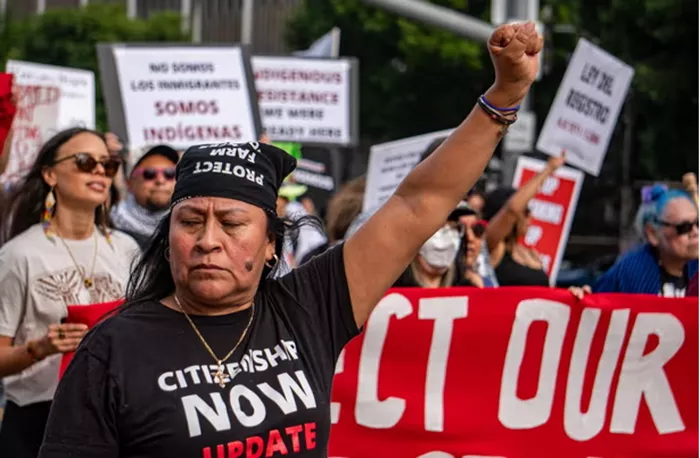California, home to the largest immigrant population in the United States, is bracing for what could be the “largest deportation operation in American history,” as former President Donald Trump sets his sights on a second term. With advocates urging state leaders to act swiftly, there are growing concerns about how the state and other “blue” states will respond to this new threat.
California led the fight against Trump’s first term, passing a sanctuary law that limited cooperation between local authorities and federal immigration agents. This law provided a buffer for many non-citizens, reducing the number of deportations significantly. However, immigrant rights groups say that Trump’s latest deportation plan poses an even greater challenge, one that demands an aggressive, coordinated response.
Chris Newman, general counsel for the National Day Laborer Organizing Network, based in California, said communities are preparing for what could be a “massive mobilization.” However, he expressed concern that lawmakers have not adequately planned for the worst-case scenario, noting that much of their attention has been on supporting Vice President Kamala Harris rather than addressing the looming deportation threat.
Trump has vowed to expel up to 20 million undocumented immigrants if he wins a second term, a plan that would far exceed the deportations carried out during his first presidency. The current strategy includes mass detention camps and deploying the National Guard and local police to assist in rounding up immigrants. These measures could disrupt the lives of many who have lived in the U.S. for years.
During his first term, Trump’s deportation efforts fell short of his goals, partly due to California’s sanctuary policies. The state was the first to implement such laws in 2017, severely limiting local law enforcement’s cooperation with U.S. Immigration and Customs Enforcement (ICE). As a result, the number of immigrants handed over to ICE dropped significantly.
However, the sanctuary law was not without its weaknesses. It was amended to allow state prisons to work with ICE, and it did not fully restrict police data-sharing with federal authorities. These loopholes continue to put some immigrants at risk, activists say.
In response, some lawmakers have pushed for stronger sanctuary policies, but Governor Gavin Newsom has repeatedly vetoed measures that could provide greater protections. In 2023, he rejected a bill that would have stopped the transfer of immigrants from state prisons to ICE. These vetoes have led some to criticize Newsom for not doing enough to protect immigrants, especially as Trump’s deportation plans gain momentum.
“California is complicit in feeding the deportation machine,” said Anoop Prasad, advocacy director of the Asian Prisoner Support Committee. “Governor Newsom needs to recognize the urgency of the situation and take stronger action.”
Immigrant rights attorney Ahilan Arulanantham, co-director of the Center for Immigration Law and Policy at UCLA, urged the state to focus on evidence-based policies that have been shown to improve public safety. He emphasized that jurisdictions that limit cooperation with ICE do not see an increase in crime. “The rational policy is to limit cooperation with ICE because there’s no evidence it makes us safer, and it tears communities apart,” he said.
Arulanantham also suggested that California should increase funding for legal defense programs to help immigrants facing deportation. During Trump’s first term, the state attempted to ban private immigration detention facilities, but the effort was blocked in court. Advocates are now looking for other ways to counter the expansion of such facilities.
Prasad added that the deportation system is deeply woven into the state’s infrastructure, involving not only state resources but also airports, roads, and private companies that assist ICE with transportation. He pointed to Washington State’s example, where a county attempted to block deportation flights but was ultimately overruled by the courts.
Governor Newsom has the option of using his power to pardon immigrants with old criminal records, shielding them from deportation. Although he has granted pardons in the past, Newsom’s clemency rate has been lower than that of his predecessor. Angela Chan, assistant chief attorney at the San Francisco Public Defender’s Office, said pardons could be a crucial tool to protect long-term immigrants who are at risk of deportation for past offenses.
As the situation unfolds, local leaders are also stepping up. Los Angeles Mayor Karen Bass has pledged to stand by immigrants, regardless of their origin or status. But she has faced scrutiny over her recent appointment of Jim McDonnell as LAPD chief. McDonnell, who previously served as sheriff and cooperated with ICE during Trump’s first term, has promised that the LAPD will not assist with mass deportations.
Advocates like Titilayo Rasaki of La Defensa, a Los Angeles-based immigration rights group, say they are ready to respond. Her organization plans to expand its court monitoring program and ensure that immigrants facing deportation have legal representation. “We’re ready. We’re resilient. We will continue to fight,” she said.
As the state prepares for the worst, the outcome of this battle may hinge on the ability of California’s lawmakers and communities to outmaneuver Trump’s aggressive immigration agenda. With increasing pressure on the state to take more decisive action, advocates remain hopeful that new strategies will emerge to safeguard immigrant rights.
Related topics:
- Donald Trump’s Election Sparks Fear Among Immigrant Communities
- Providence, R.I. Public Schools Commit to Improving Education for Immigrant Students
- Immigrant Rights Groups Rally Ahead of Trump’s Inauguration


